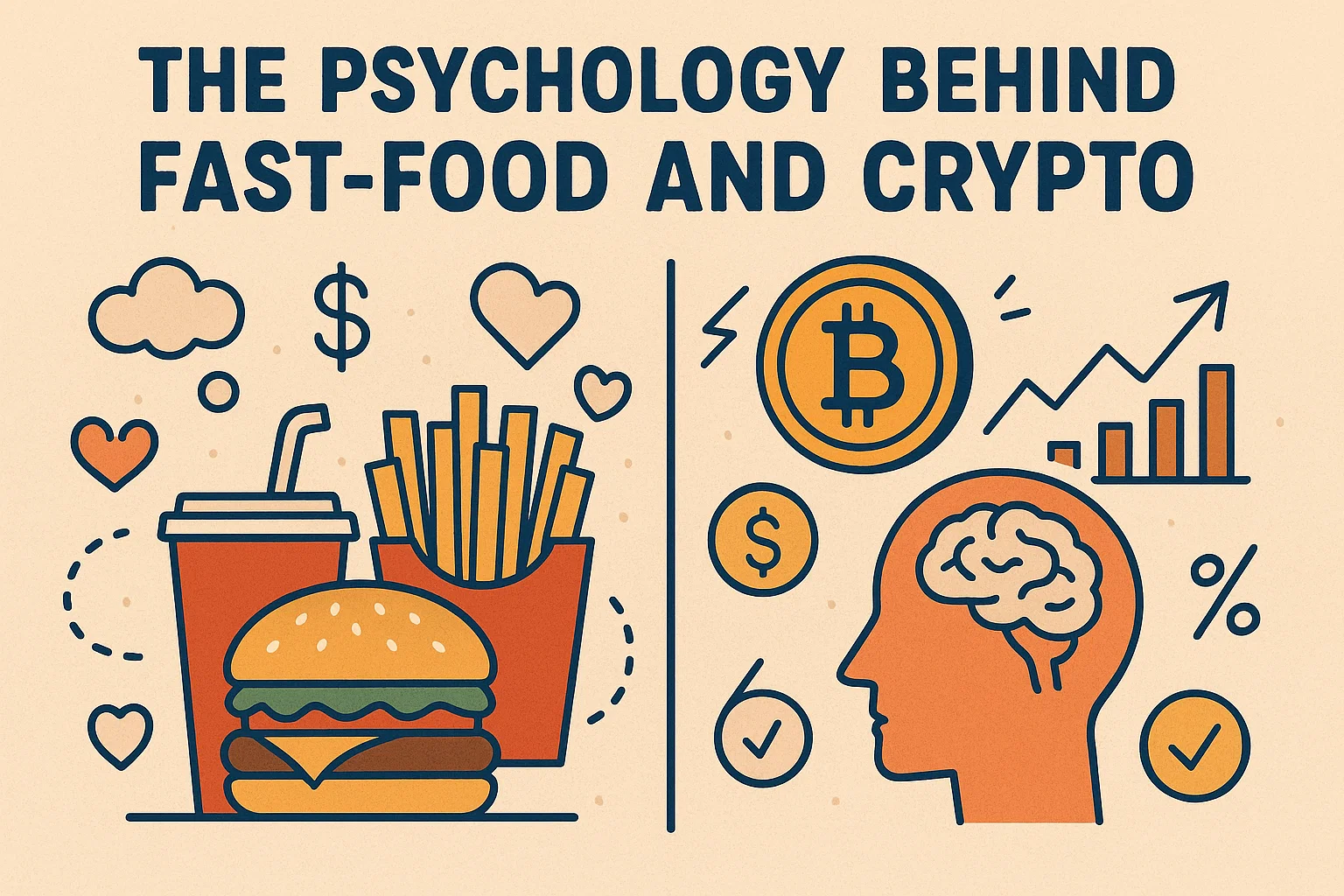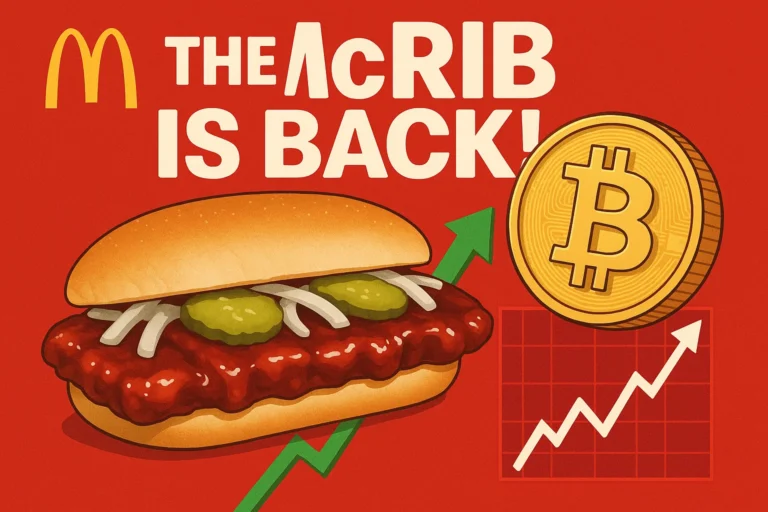Every few years, McDonald’s resurrects its legendary McRib sandwich, and each time, the internet reacts like clockwork. Fast-food fans celebrate, and the financial corners of social media—especially crypto Twitter—ignite with a familiar joke: will the McRib return pump Bitcoin again? This idea sounds humorous, but beneath the memes lies an intriguing behavioral link between pop-culture attention and speculative trading. In a world where sentiment drives volatility and virality influences liquidity, even a limited-time sandwich can become a symbol of market optimism.
Analysts and traders have started to notice that cultural events, no matter how trivial, can sometimes align with shifts in risk appetite. To uncover whether this hype cycle has any measurable effect, we asked financial experts, on-chain data analysts, behavioral economists, and traders how much truth there might be in the notion that the McRib return pump Bitcoin phenomenon is more than just a meme.
Will the McRib Return Pump Bitcoin?
Most professionals will tell you that a fast-food item cannot single-handedly move a trillion-dollar asset. Yet the idea persists because markets thrive on shared stories. When McDonald’s revives the McRib, social media lights up, generating a surge in collective attention. Traders who live in the same digital spaces pick up that energy. The phrase McRib return pump Bitcoin functions as a symbolic headline, a rallying cry reminding participants that the crypto market loves coordinated moments.
Every trader knows attention is currency, and when that attention peaks around something humorous yet universal, price momentum can follow—sometimes ironically, sometimes seriously. The McRib’s return, therefore, becomes a proxy for optimism and risk-on behavior, a small spark in an ocean of liquidity that might influence short-term sentiment if the timing aligns with broader bullish catalysts.
The Psychology Behind Fast-Food and Crypto
Behavioral finance offers insight into why memes like this matter. Human beings are wired to respond to scarcity and novelty. McDonald’s engineered the McRib to appear only for short periods, creating an illusion of exclusivity and urgency. That same “limited-time only” impulse drives people to act quickly before missing out. In trading, this is known as FOMO—the fear of missing out—which has fueled every major crypto bull run.

When traders see the McRib return pump Bitcoin meme circulating, it triggers both humor and subconscious recognition of that scarcity dynamic. The joke feels relatable, and relatability strengthens collective action. The overlap between cultural scarcity and market speculation turns into an echo chamber where every mention of the McRib adds noise—and sometimes, that noise turns into real volume.
Memes have become trading signals. In a hyperconnected world, virality can generate micro-rallies purely through the belief that others will act on the meme. If enough people think that the McRib return pump Bitcoin scenario might play out, a feedback loop forms: traders buy in anticipation of others buying. This self-fulfilling cycle doesn’t need fundamentals—it only requires shared attention.
What Analysts Are Watching This Season
Professional traders who humor the idea of a McRib effect focus on data rather than jokes. They monitor on-chain metrics such as stablecoin inflows, perpetual futures open interest, and funding rate movements around cultural events. If the McRib return pump Bitcoin narrative trends on social platforms and data simultaneously shows new money entering exchanges, the link becomes at least observable. It might not be causation, but it’s often correlation worth noting.
Options desks watch short-term call volume and implied volatility shifts that occur around the same time, since retail traders chasing memes often do so through leveraged derivatives. Meanwhile, social analytics firms track the velocity of mentions—the number of posts per minute containing both “McRib” and “Bitcoin.” If engagement grows consistently rather than in a brief spike, it may represent a genuine narrative phase capable of moving marginal flows.
These metrics rarely confirm direct influence, but they reveal how cultural attention affects speculative rhythm. The McRib’s comeback often lands in the fourth quarter, a historically volatile period for digital assets due to macro liquidity rotations and tax positioning. In that context, even a seemingly lighthearted trigger can line up with structural inflection points. For traders seeking to anticipate crowd behavior, ignoring such coincidences would mean ignoring sentiment itself.
How Traders Approach the Narrative
Some traders treat the McRib return pump Bitcoin theme as an event-driven trade, not an investment thesis. They define a short-term window—usually a few days—to test whether attention and price start moving in tandem. If the story gains traction online but fails to reflect on charts, they exit quickly. The strategy depends on discipline: when sentiment fades, exposure must shrink. Others prefer to participate through spot holdings, maintaining Bitcoin positions while observing how narrative intensity changes. The key is understanding that this is not about fundamentals; it’s about exploiting temporary social momentum.
Professional portfolio managers describe it as “trading the reaction, not the headline.” The moment the McRib announcement becomes public, social chatter surges. Traders gauge how this chatter translates into funding rates and short-term market structure. If funding remains stable and open interest rises gradually, that implies spot-driven accumulation, which can extend a rally. But if funding spikes aggressively without spot confirmation, the setup is likely speculative leverage that will unwind quickly. In that case, the McRib return pump Bitcoin notion turns from opportunity to cautionary tale.
Lessons from Past Cultural Market Moments
The intersection of culture and crypto has precedent. Elon Musk’s tweets about Dogecoin showed that humor and timing could temporarily move markets. Major sports events, award shows, or viral challenges have all coincided with short bursts of speculative energy. These moments highlight how social synchronization matters more than the topic itself. The McRib return pump Bitcoin idea fits within that lineage—a pop-culture event acting as a mirror for risk sentiment.
Historically, when the McRib has returned during optimistic market conditions, traders have noticed small upticks in Bitcoin momentum, though none statistically significant. Still, those coincidences stick in collective memory, fueling future jokes that could, paradoxically, become real signals. If the McRib drops during a period of rising global liquidity or dovish monetary sentiment, the meme could serve as the cultural spark that aligns with real buying pressure. Markets are stories layered on top of math, and every story has power when enough people believe it.
Why Macro Still Dominates the Menu
Despite the fun of the meme, macroeconomics remains the true driver. Bitcoin responds more to Federal Reserve policy, ETF inflows, and bond yields than to sandwich marketing. Liquidity is the oxygen of risk assets, and no amount of fast-food nostalgia can replace it. Analysts emphasize that while the McRib return pump Bitcoin idea captures attention, traders must always check broader indicators.

Such as the strength of the U.S. dollar, the slope of the yield curve, and global risk sentiment. In times of tightening liquidity, no meme can sustain momentum; in times of easing, even a meme can multiply a move. Understanding that context transforms the joke into a useful psychological gauge rather than a literal forecast.
What the Experts Say
Behavioral economists explain that humans crave synchronization—moments when everyone looks at the same thing. Cultural scarcity, like the McRib’s seasonal return, generates shared anticipation, which markets often convert into collective participation. That’s why the McRib return pump Bitcoin meme resonates: it represents a communal signal. Market microstructure analysts focus on liquidity flows, observing that brief narrative bursts can cause short-term imbalances as retail traders cluster around a theme.
Quantitative portfolio managers highlight the need for multi-platform confirmation; a trend visible only on X (formerly Twitter) is noise, but one spanning Reddit, TikTok, and Telegram can achieve the cross-platform density that defines a real meme phase. Options traders, meanwhile, note that surging short-dated call buying is often the hallmark of such phenomena. Once those options decay, the trade usually collapses. The common thread in their insights is that memes can move markets—but only for as long as they remain funny, relevant, and shared.
Understanding the Risks
For every viral success, there are dozens of forgotten jokes. The danger in chasing the McRib return pump Bitcoin story lies in survivorship bias: traders remember the one coincidence when Bitcoin rose after a McRib comeback and forget all the times it didn’t. Acting on selective memory leads to poor risk management. Another danger is liquidity illusion.
Small meme tokens or speculative derivatives often surge on hype and crash once attention shifts. Without tight risk limits, traders can suffer outsized losses chasing irony. It is essential to separate news from narrative. A McDonald’s press release is merely an event; interpreting it as a market catalyst is a choice. Responsible traders watch how the market reacts rather than assuming it must react.
How Brands Accidentally Feed Crypto Hype
Interestingly, corporations like McDonald’s rarely intend to influence financial markets, yet their marketing campaigns sometimes trigger ripple effects. The meme economy thrives on repurposing mainstream symbols. When a global brand creates a limited-time frenzy, crypto traders co-opt that energy, transforming it into speculative humor.
The McRib return pump Bitcoin phrase represents the fusion of marketing virality with digital-asset reflexivity. Both systems reward attention, both monetize curiosity, and both rely on constant engagement. The overlap is inevitable. This blending of cultural and financial ecosystems is a hallmark of modern markets, where a trending sandwich can share digital real estate with trillion-dollar charts.
Strategies by Market Type
Long-term investors view the McRib meme as noise. They might enjoy the social buzz but remain focused on accumulation and macro signals. For them, the McRib return pump Bitcoin discussion is an amusing reminder that sentiment is cyclical. Swing traders treat it as a potential sentiment catalyst; they look for confirmation across funding rates, volume trends, and social velocity before taking short-term positions.
For the more speculative crowd, often called degens, the narrative becomes a playground for small, high-risk trades made purely for entertainment. Even then, discipline matters. Each group, regardless of strategy, must remember that narrative trades are temporary. Once the laughter fades, so does the liquidity.
Conclusion
So, will the McRib return pump Bitcoin again? The answer depends less on the sandwich and more on sentiment. Cultural moments like these remind us that markets are not purely rational—they are reflections of human emotion, humor, and herd behavior. A fast-food comeback may not move billions, but it can move the mood. And in crypto, mood often precedes motion.
Traders who understand this dance between culture and capital can use it as a soft indicator, a way to gauge how ready the crowd is for risk. Whether you view the McRib meme as an absurd joke or a subtle sentiment signal, it offers a lesson: attention is the ultimate currency. Keep your eyes on the charts, your emotions in check, and if you’re curious about timing, maybe grab a sandwich and see if the McRib return pump Bitcoin story cooks up one more surprise.
Frequently Asked Questions
Q: Can a sandwich really move Bitcoin?
Realistically, no. But memes can influence marginal traders, and marginal traders can influence short-term price action. That is the foundation of the McRib return pump Bitcoin hypothesis.
Q: How long could any such effect last?
Historically, meme-driven moves persist for a few hours to a few days before retracing.
Q: Should traders act on it?
Only if they treat it as a speculative, time-bounded opportunity rather than a serious thesis. The narrative is an optional trade, not an investment principle.
Also Read: Web3 AI Offers 1,747% ROI With Real Utility in Crypto Presale

